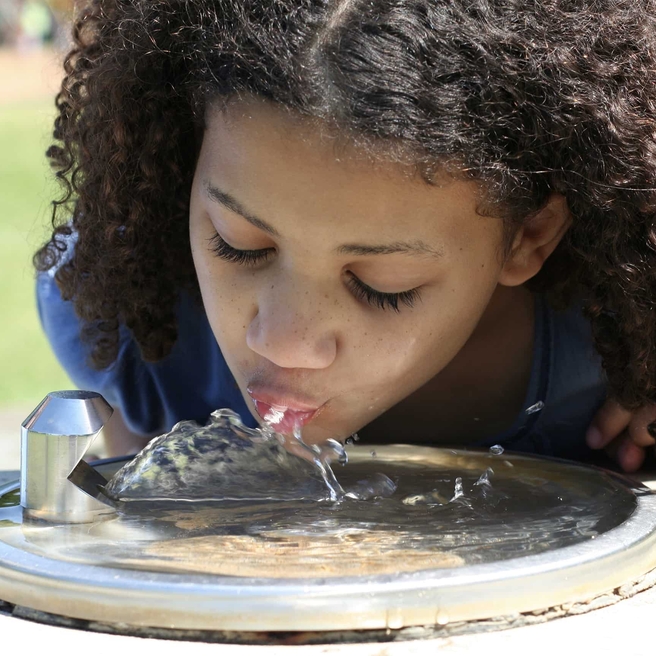
Once considered an adult disease, kidney stones have become more common among children and adolescents over the past few decades. The reasons for this increase are not entirely clear, but a number of factors may play a role, including diet, family history, and not drinking enough fluids.

Despite the growing number of cases, kidney stones are still relatively uncommon in children. When they do occur, though, they can be painful and upsetting for kids and their families.
What are kidney stones?
Kidney stones occur when minerals become concentrated in the urine and form solid crystals. If these crystals get stuck in the ureter, the tube that drains the urine into the bladder, they can obstruct the drainage of urine, causing pain and discomfort. Some stones are passed on their own. Those that don’t can be removed surgically or through less invasive procedures.
Symptoms of kidney stones
- Sharp pain in the back or abdomen
- Blood in the urine
- Nausea and vomiting, when occurring with the previous two symptoms
Tips for preventing kidney stones
“At the Pediatric Kidney Stone Center, where we specialize in treating kids with kidney stones, prevention is extremely important,” says Gregory Tasian, MD, MSc, MSCE, an attending pediatric urologist at The Children’s Hospital of Philadelphia and a world-renowned pediatric kidney stone expert.
While the Center team creates individualized prevention plans for each child depending on the exact cause of the stones, a key component of these plans is making dietary changes. What your child eats and drinks affects his urine chemistry, which can influence his kidney stone risk.
The following recommendations may help prevent kidney stones in children:
- Increase fluids. Your child should drink a minimum of half his body weight in ounces of water every day. For example, an 80-pound child should drink 40 ounces of water every day. Proper hydration helps prevent urine from becoming concentrated with crystals, which can lead to the formation of stones. The color of your child’s urine may give clues to the concentration of the urine. Dark or bright yellow urine indicates highly concentrated urine, while pale or colorless urine indicates a lower urine concentration.
- Make sure your child drinks enough fluids all year round. A recent study by CHOP’s Stone Center specialists found that stone risk rises during times of temperature extremes (the heat of summer and cold of winter), when there is also a higher incidence of dehydration.
- Eat the right balance of meat, salt and foods high in oxalate (such as green leafy vegetables, chocolate and nuts).
- Protein: Children should still get their recommended daily allowance of protein to support growth, but a diet that’s too high in protein can cause an increase in acid in the body. Too much acid can lead to a decrease of a “good” chemical, called urinary citrate, which helps prevent stones. You can achieve the right balance by limiting the amount of protein your child eats at each meal.
- Salt: An increased amount of salt in the diet can increase calcium levels in the urine, which raises the risk for kidney stones. The United States Department of Agriculture (USDA) recommends limiting sodium intake to less than 2,400 milligrams of sodium each day, but CHOP’s Stone Center recommends patients limit their intake to no more than 2,000 milligrams of sodium per day.
- Calcium: Make sure your child gets enough dietary calcium. A lot of calcium in your food is a good thing; a lot of calcium in your urine (which is caused by too much sodium, as noted above) is a bad thing. Studies in adults have found that normal to high dietary calcium intake decreases urine oxalate and, thus, decreases the risk of kidney stones. CHOP’s Stone Center hopes to perform these studies among children, but the bottom line is don’t limit calcium in your child’s diet, as this can actually increase the risk of kidney stones.
Read our Kidney Stone Prevention and Dietary Plan for more general nutrition guidelines and nutrition to help prevent kidney stones.
Featured in this article
Specialties & Programs
Once considered an adult disease, kidney stones have become more common among children and adolescents over the past few decades. The reasons for this increase are not entirely clear, but a number of factors may play a role, including diet, family history, and not drinking enough fluids.

Despite the growing number of cases, kidney stones are still relatively uncommon in children. When they do occur, though, they can be painful and upsetting for kids and their families.
What are kidney stones?
Kidney stones occur when minerals become concentrated in the urine and form solid crystals. If these crystals get stuck in the ureter, the tube that drains the urine into the bladder, they can obstruct the drainage of urine, causing pain and discomfort. Some stones are passed on their own. Those that don’t can be removed surgically or through less invasive procedures.
Symptoms of kidney stones
- Sharp pain in the back or abdomen
- Blood in the urine
- Nausea and vomiting, when occurring with the previous two symptoms
Tips for preventing kidney stones
“At the Pediatric Kidney Stone Center, where we specialize in treating kids with kidney stones, prevention is extremely important,” says Gregory Tasian, MD, MSc, MSCE, an attending pediatric urologist at The Children’s Hospital of Philadelphia and a world-renowned pediatric kidney stone expert.
While the Center team creates individualized prevention plans for each child depending on the exact cause of the stones, a key component of these plans is making dietary changes. What your child eats and drinks affects his urine chemistry, which can influence his kidney stone risk.
The following recommendations may help prevent kidney stones in children:
- Increase fluids. Your child should drink a minimum of half his body weight in ounces of water every day. For example, an 80-pound child should drink 40 ounces of water every day. Proper hydration helps prevent urine from becoming concentrated with crystals, which can lead to the formation of stones. The color of your child’s urine may give clues to the concentration of the urine. Dark or bright yellow urine indicates highly concentrated urine, while pale or colorless urine indicates a lower urine concentration.
- Make sure your child drinks enough fluids all year round. A recent study by CHOP’s Stone Center specialists found that stone risk rises during times of temperature extremes (the heat of summer and cold of winter), when there is also a higher incidence of dehydration.
- Eat the right balance of meat, salt and foods high in oxalate (such as green leafy vegetables, chocolate and nuts).
- Protein: Children should still get their recommended daily allowance of protein to support growth, but a diet that’s too high in protein can cause an increase in acid in the body. Too much acid can lead to a decrease of a “good” chemical, called urinary citrate, which helps prevent stones. You can achieve the right balance by limiting the amount of protein your child eats at each meal.
- Salt: An increased amount of salt in the diet can increase calcium levels in the urine, which raises the risk for kidney stones. The United States Department of Agriculture (USDA) recommends limiting sodium intake to less than 2,400 milligrams of sodium each day, but CHOP’s Stone Center recommends patients limit their intake to no more than 2,000 milligrams of sodium per day.
- Calcium: Make sure your child gets enough dietary calcium. A lot of calcium in your food is a good thing; a lot of calcium in your urine (which is caused by too much sodium, as noted above) is a bad thing. Studies in adults have found that normal to high dietary calcium intake decreases urine oxalate and, thus, decreases the risk of kidney stones. CHOP’s Stone Center hopes to perform these studies among children, but the bottom line is don’t limit calcium in your child’s diet, as this can actually increase the risk of kidney stones.
Read our Kidney Stone Prevention and Dietary Plan for more general nutrition guidelines and nutrition to help prevent kidney stones.
Contact us
Pediatric Kidney Stone Center